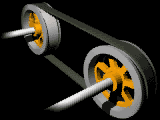A Belt is a looped strip of
flexible material, used to mechanically link two or more
rotating shafts. They may be used as a source of motion,
to efficiently
transmit power, or to track relative movement. Belts
are looped over
pulleys. In a two pulley system, the belt can either
drive the pulleys in the same direction, or the belt may
be crossed, so that the direction of the shafts is
opposite. As a source of motion, a
conveyor belt is one application where the belt is
adapted to continually carry a load between two points.






Belts are the cheapest utility for
power transmission between shafts that may not be
parallel. Power transmission is achieved by specially
designed belts and pulleys. The demands on a belt drive
transmission system are large and this has led to many
variations on the theme. They run smoothly and with
little noise, and cushion motor and bearings against
load changes, albeit with less strength than gears or
chains. However, improvements in belt engineering allow
use of belts in systems that only formerly allowed
chains or gears.
Belt drive, moreover, is simple,
inexpensive, and does not require parallel shafts. It
helps protect the car from overload and jam, and damping
it from noise and vibration. Load fluctuations are
shock-absorbed (cushioned). They need no lubrication and
minimal maintenance. They have high efficiency (90-98%,
usually 95%), high tolerance for misalignment, and are
inexpensive if the shafts are far apart. Clutch action
is activated by releasing belt tension. Different speeds
can be obtained by step or tapered pulleys.
However, the angular-velocity ratio is
not constant or equal to that of the pulley diameters,
due to slip and stretch. Heat accumulation is present,
and speed is limited to approximately 7000 ft/min, and a
power of only 500 hp (370 kW). Temperatures ranges from
-31 to 185 °F (85 °C). Adjustment of center distance or
addition of an idler pulley is crucial to compensate for
wear and stretch.















